Even if you hate apple picking...
You can still exploit the changing season on behalf of your art.
I went for a hike this weekend on a path that was still fairly green; green leaves, green ferns, green stems holding up the final, most persistent petals on the end-of-summer flowers. But, along the way a scattering of Autumn colors appeared; a burnt orange here, a fallen scarlet red leaf there, some dots of burnished yellow and green leaves trimmed with gold. There was the occasional bald spot in the canopy of a tree and a small pile of fallen leaves on the base of a tree trunk. Soon enough that same path will be nothing but the colorful signs of another summer coming to an end.
In a normal year the kind of people who yearn to look at changing leaves would be planning a trip upstate or to Vermont or through Northern Minnesota or to some other place where the air smells like apple cider donuts and you can pick your own pumpkin.
What does this change of season mean for you, the painter? It should mean something because you should always be on the lookout for things to exploit for your own painting pleasure. Waiting for inspiration is a fool’s game, a proactive painter is a prolific painter and in my book, the more you paint, the better you will become. Your job as an artist is to be always aware of the world around you so you can capture it in the way that only you can capture it.
So what should you do with the autumn tableau you will soon find yourself living in, if you live far enough from the Equator to enjoy the full range of seasons?
What you paint might depend on how you feel about the end of summer. Let’s look at a few poems to show you what I mean. My guess is, based on the not-uplifting tone of this poem called “Fall, Leaves, Fall” (which could have just have easily been called, “A depressing little poem about my least favorite season.”) that Emily Bronte hates Autumn:
Fall, leaves, fall; die, flowers, away;
Lengthen day and shorten day;
Every leaf speaks bliss to me
Fluttering from the autumn tree.
I shall smile when wreaths of snow
Blossom where the rose should grow;
I shall sing when night’s decay
Ushers in a drearier day.
Point taken, Ms. Bronte.
But then the poet Mary Oliver is obviously enthralled by the arrival of Fall, just like she is enthralled by all of the shifting and fading of the natural world:
“And don’t you hear
the goldenrod whispering goodbye,
the everlasting being crowned with the first
tuffets of snow?”
So you can be inspired by the poets and bring your mood about autumn or the changing landscape to your work by drenching your canvas in the moody Autumn shades. Or, you can look to other painters to see how they make the most of this brief bit of cool air before the cold.
Like Alex Katz, you could focus on the shapes of the trees that emerge when the leaves have begun to fall, a thinned out, more cubist, less rococo version of a tree’s summer and spring self that is not yet the stark minimalism of winter that appears when all the leaves have fallen. You could do a painting of leaves so simple that it is practically an abstract art piece.
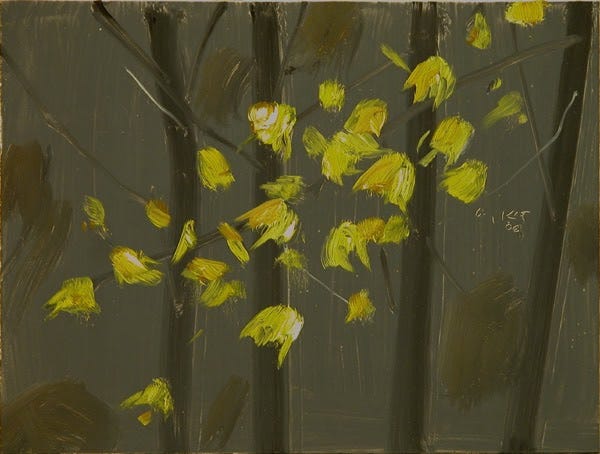
Alex Katz
Yellow Leaves #5, 2006
Oil on board
9 × 12 in
Or, you could go foraging for leaves to paint and, like Janet Fish, bring them inside to join some fruit for a still life. You don’t even need to leave town, just pick some up on the sidewalk or in your neighborhood park or your own backyard.
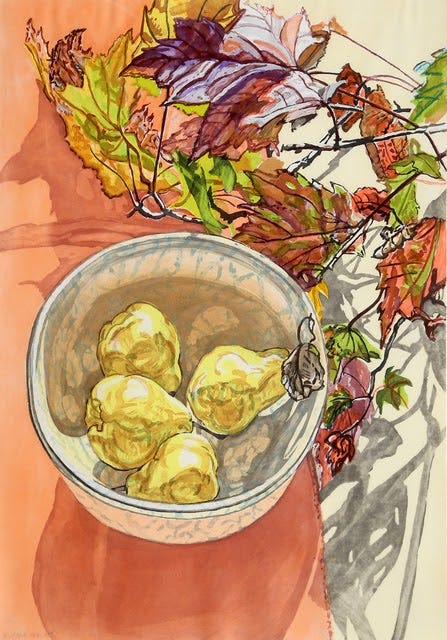
Janet Fish
Pears and Autumn Leaves
1988
Lithograph
Do you have time to sit and ponder an orchard as it is being overtaken by the chain of events needed to shift the world from green to orange? Then go outside and paint in real life, like Van Gogh. Or, find a photo you would like to paint of a forest you love.

Vincent van Gogh
Autumn Landscape with Four Trees
1885
Kröller-Müller Museum, Otterlo
I can’t imagine a more worthy subject of close up examination by a painter than a leaf being taken over by Fall. Looking closely at them, an Autumn leaf seems almost fictional, like something added to an animated film to make it more appealing to children. How can one tiny object be so worthy of so many twists and turns of color? How can so many different colors, too brilliant to be recreated using man-made paints, share so few square inches? But they do and the opportunity they offer you to play with color is endless.
Look at what the queen of the botanical close-ups, Georgia O’Keeffe, did with a few Fall leaves. In a style of painting often called Precisionism, O’Keeffe reduced whatever she was painting to a few simple shapes and forms. If you are new to painting, this is a great way to practice both handling of paint and looking at an object without feeling intimidated. Just get the most basic facts about your leaves onto your paper. Look at how the main vein curves through the leaf, try to capture the approximate shape of the edges, the blobs and triangles of color. Don’t go for perfectionism, go for the general vibe and shape of you object.
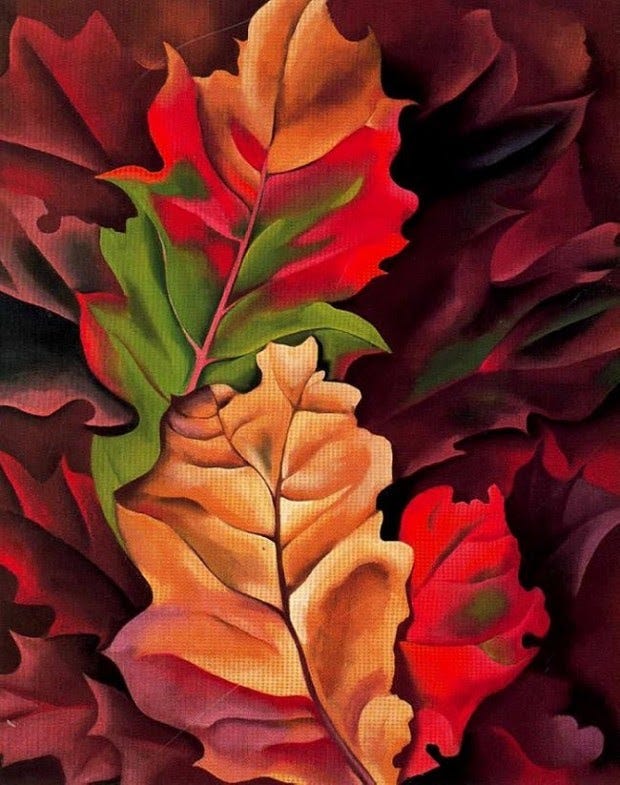
Georgia O'Keeffe
Autumn Leaves
1924
private collection
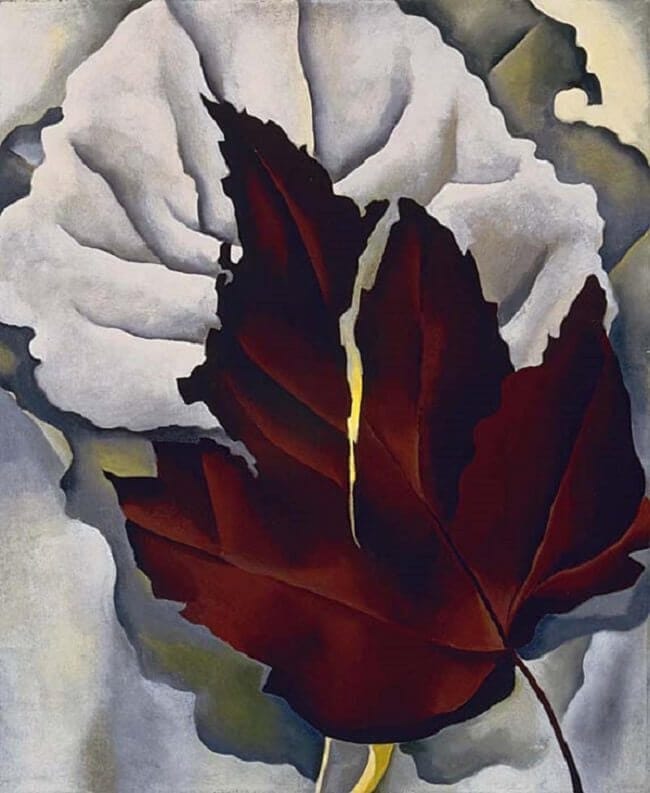
Georgia O’Keeffe
Pattern of Leaves
1924
If you are a more advanced painter, and somebody who likes to person a figure into everything you paint, try surrounding your model with a sea of rust, amber, burgundy and purple. What does that sea of warm colors mean for how you paint the model? Since we know that the thing that really matters in regards to colors in a painting is the relationship between the colors, what happens if you drop a green dress or blue-tinted skin tone into your scene?
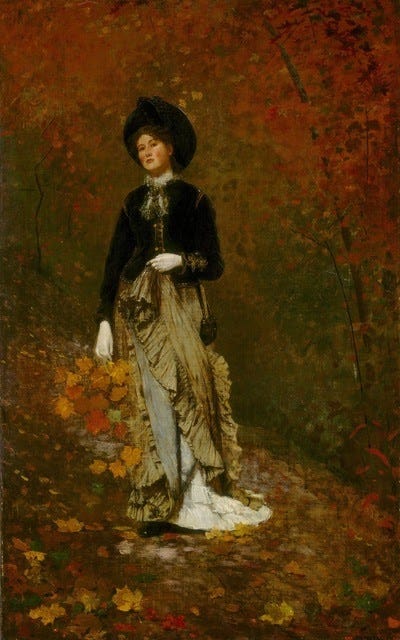
Autumn, 1877
Oil on canvas
38 1/4 × 23 3/16 in
National Gallery of Art, Washington, D.C.
As the days get shorter, the pandemic lingers and the election season has us all pulling our hair out, go for a walk. Look for a leaf or two. And lose yourself in a moment in the very hard but satisfying job of capturing the world in the most simple of objects.



